Chapter 6: Migration
"Migration has been the main driver of Scotland’s population growth for the past 19 years”
Migration and COVID-19
The first part of this chapter summarises the latest migration statistics up to December 2019, prior to the outbreak of COVID-19 in the UK. In 2020, it is expected that migration to and from Scotland (especially overseas migration) will decline due to travel restrictions having been put in place by most countries during the pandemic.
The last two sections of this chapter present alternative data covering a time period up to June 2020. However, it is important to note that these are not direct measures of migration but rather provide some partial insights as to how the COVID-19 pandemic is impacting other areas, including international air travel and National Insurance number allocations to overseas nationals entering the UK.
Scotland’s migration trends
Net migration (the difference between inward and outward migration) has been fluctuating in recent years; however, there are still more people coming to Scotland than leaving, adding to Scotland’s population, as shown in Figure 6.1. In the year to June 2019, 30,200 more people moved to Scotland than left, an increase after two years of decline in net migration following the UK’s decision to leave the EU.
Before the early 1990s, more people left than moved to Scotland. Net migration was at an all-time low in 1966 (-43,200 people), but then began increasing steadily over time. Since mid-2001, net migration remained positive and increased over the next decade, especially in the years after the expansion of the EU in 2004. Net migration peaked in mid-2007 when 33,000 more people moved to Scotland than left.
Net migration is the difference between the number of long-term migrants entering Scotland and the number of long-term emigrants leaving the country.
A long-term migrant is defined as someone who changes their usual country of residence for a period of 12 months or longer.
Figure 6.1: Net migration, Scotland, mid-1959 to mid-2019
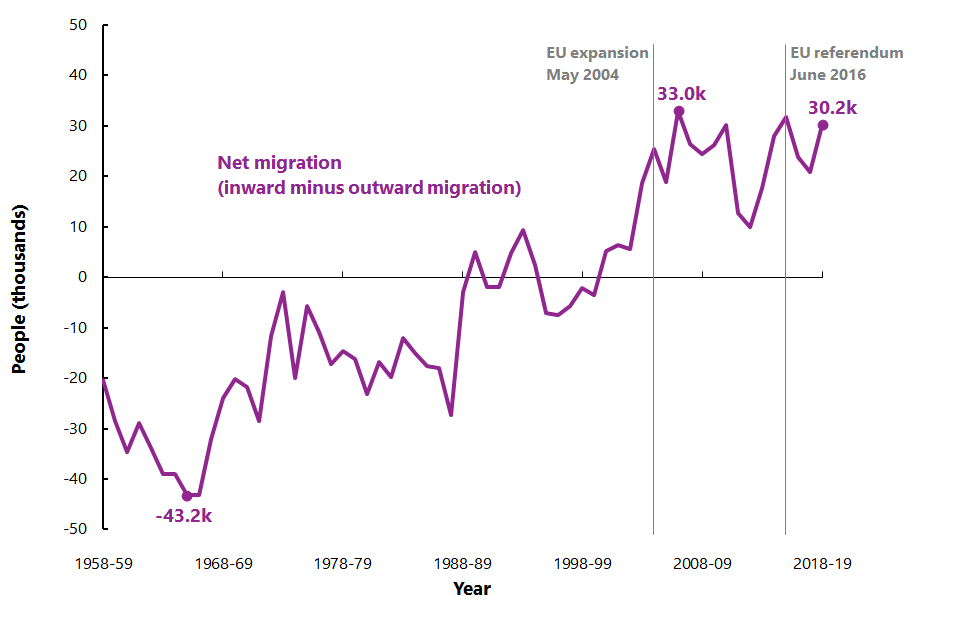
Note: The EU has expanded a number of times throughout its history. The 2004 enlargement was the largest single expansion of the EU. More details of which countries are part of the EU can be found in Appendix 3.
Where are people coming from and going to?
As well as looking at trends in overall net migration, we can look at migration flows in a little more detail to understand what drives the change in net migration. Figure 6.2 shows where people were coming from and going to in the year to June 2019.
Over the year to June 2019, there were small decreases in migration flows between Scotland and the rest of the UK:
- 47,500 people came from the rest of the UK to live in Scotland; 200 fewer than in mid-2018
- 37,400 people left Scotland to move to another UK country; 300 fewer than in mid-2018
Migration flows vary across Scotland. Breakdowns at council area and health board level can be found on the NRS website.
This means that net migration from the rest of the UK to Scotland remained positive and unchanged from the previous year, with 10,000 more people moving to Scotland than leaving for other UK countries.
Figure 6.2: Migration between Scotland, the rest of the UK and overseas, year to mid-2019
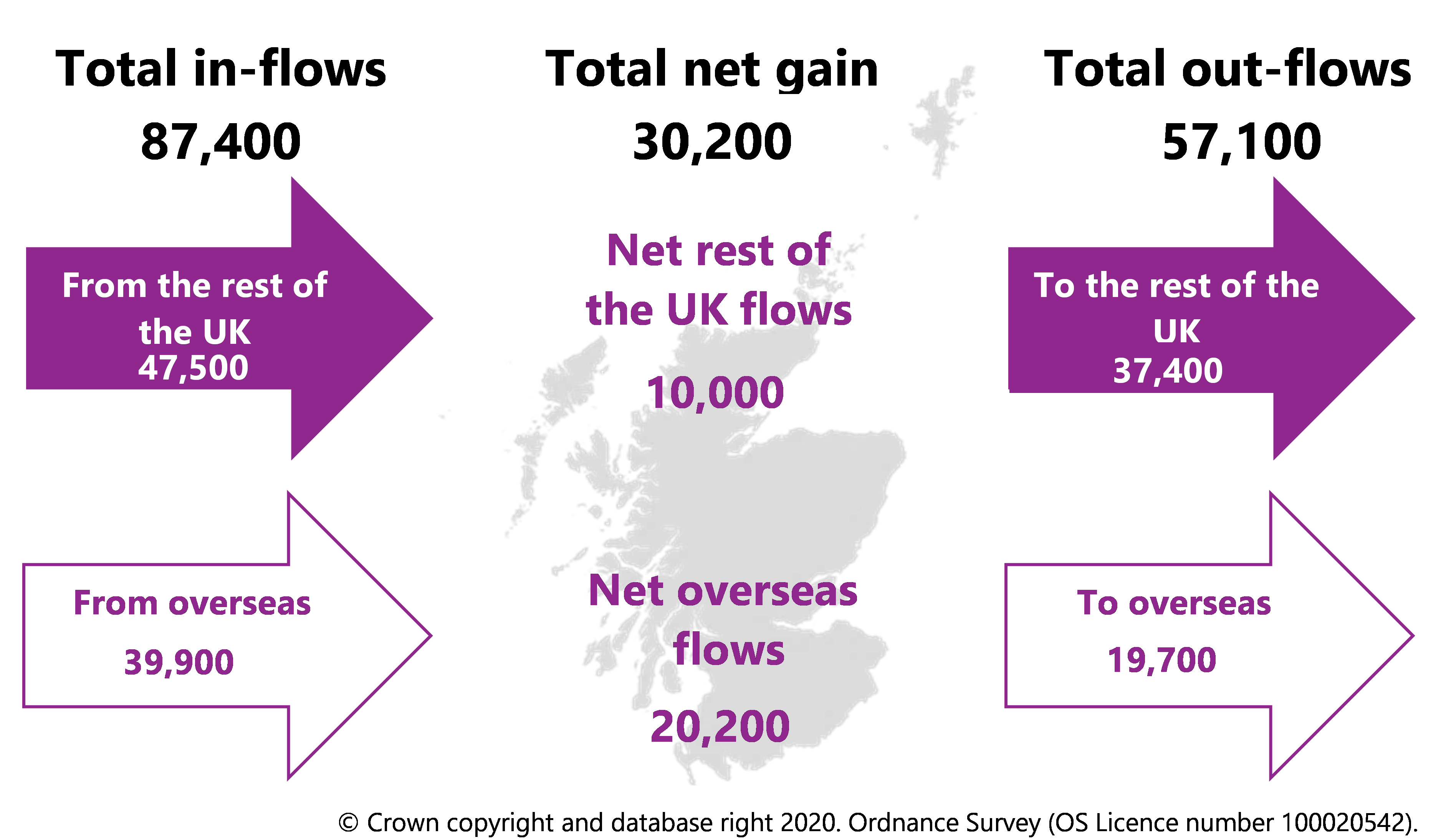
Note: Totals may not sum due to rounding.
The number of people moving to Scotland from overseas increased while the number of people leaving Scotland to move overseas decreased over the most recent year to June 2019:
- 39,900 people moved to Scotland from overseas; 7,000 more than in mid-2018
- 19,700 people moved from Scotland to overseas; 2,300 fewer than in mid-2018
Therefore, 20,200 more people moved to Scotland from overseas than left in mid-2019. This is an increase of 9,300 from the previous mid-year period.
How do we measure migration?
- International migration estimates reported in this chapter are based primarily on the International Passenger Survey (IPS). This is a sample survey conducted at the channel tunnel, main ports and airports across the UK. The sample size for Scotland is very small which means there is a higher degree of uncertainty around the estimates, and less detailed breakdowns available for Scotland compared to the UK overall.
- Migration within the UK is calculated using patient records from the NHS Central Register (in Scotland), the Personal Demographic Service (in England and Wales) and the Medical Card register (in Northern Ireland).
Future developments
- The Office for National Statistics (ONS) are developing new measures of international migration based on administrative data from November 2020. This is part of a broader transformation programme for population and migration statistics which has been ongoing for several years. However, the programme’s timeline has altered due to the suspension of the IPS in March 2020 because of COVID-19.
More detailed information on how we measure migration can be found in the mid-year population estimates methodology guide.
Non-British nationals living in Scotland
As well as understanding the flows of people entering and leaving Scotland over a period of time, it is also useful to look at the number of people currently living in Scotland who are non-British nationals. This information comes from the Annual Population Survey (carried out by the Office for National Statistics) where respondents self-report their nationality
More detailed tables on the Scottish population by nationality, as well as country of birth, can be found on the NRS website.
In 2019, there were about 388,000 non-British nationals living in Scotland, which accounted for 7% of the Scottish population. This was an increase of 36,000 people from 2018, which was mainly driven by an increase in non-EU nationals. Figure 6.3 shows how many EU and non-EU nationals were estimated to live in Scotland in 2019.
Figure 6.3: Number of non-British nationals living in Scotland, 2019
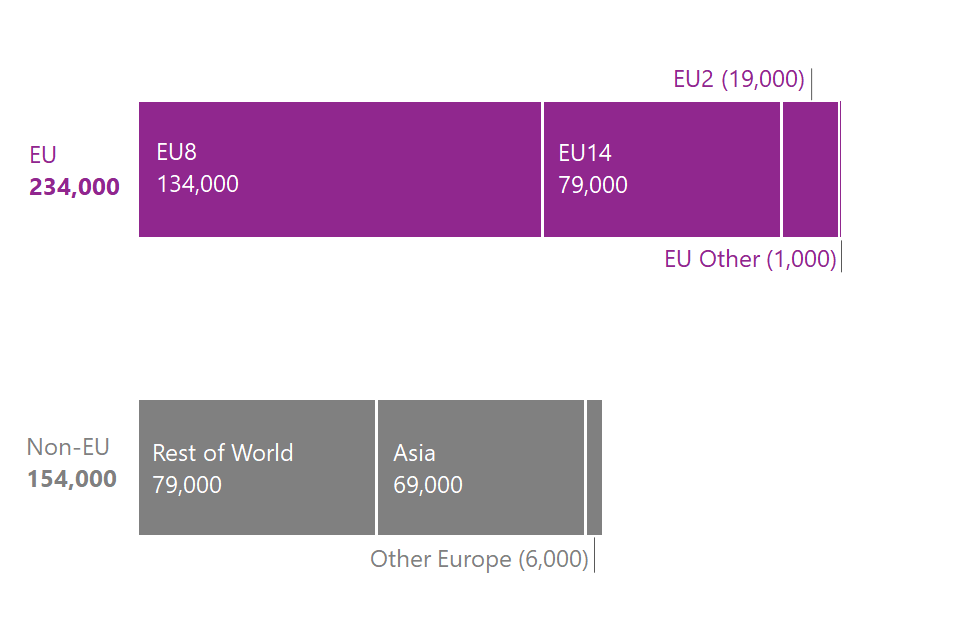
Source: Annual Population Survey, January to December 2019, Office for National Statistics Note: Totals may not sum due to rounding. More information on which countries are part of the EU and specific country groupings can be found in Appendix 3.
Of all non-British nationals living in Scotland in 2019:
- 234,000 (60%) were EU nationals, and
- 154,000 (40%) were non-EU nationals.
Most EU nationals were from EU84 countries (134,000) – these are countries that became member states of the EU in 2004. Nationals of the Rest of the World (79,000) and Asia (69,000) made up similar proportions of the non-EU population.
Polish (91,000) remained the overall most common non-British nationality and accounted for almost one quarter (23%) of all non-British nationals living in Scotland. Indian (13,000) was the most common non-EU nationality in 2019. The top 5 EU and non-EU nationalities in Scotland can be seen in Figure 6.4, and more information on which countries are part of the EU and specific country groupings can be found in Appendix 3.
4 EU8 refers to 8 of the 10 countries that became member states of the European Union on 1 May 2004. These are Czech Republic, Estonia, Hungary, Latvia, Lithuania, Poland, Slovakia and Slovenia.
Figure 6.4: Most common non-British nationalities, Scotland, 2019
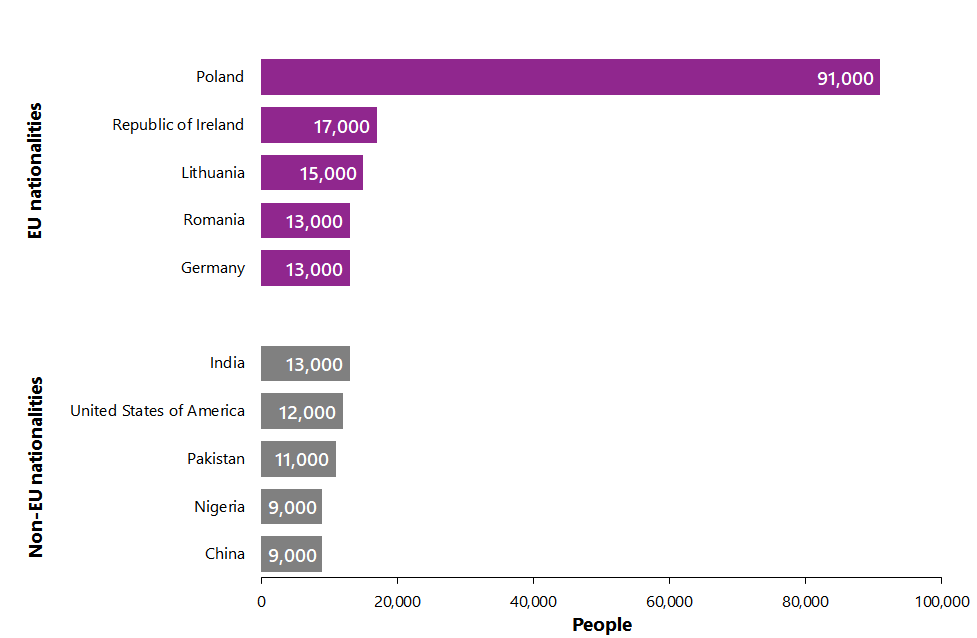
Source: Annual Population Survey, January to December 2019, Office for National Statistics
Following the UK’s departure from the EU, non-British nationals need to apply to the EU Settlement Scheme (EUSS) to secure their right to remain in the UK. So far, 196,600 applications have been received in Scotland as of 31 August 2020.
Figure 6.5: EU Settlement Scheme applications received each month, Scotland, Aug 2018 to Jun 2020
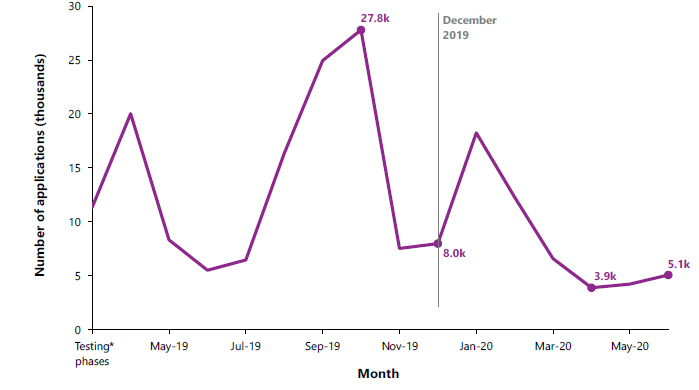
* ‘Testing phases’ refers to the period covered by the two private beta testing phases and the public beta testing phase which collectively ran between 28 August 2018 and 29 March 2019.
Source: EU Settlement Scheme quarterly statistics, June 2020, Home Office
Figure 6.5 shows how the number of applications received in Scotland has varied since the beginning of the scheme in August 2018. A peak of 27,790 applications was recorded in October 2019, the month the UK planned to leave the EU after the first extension and before the final extension to 31 January 2020. After another high in January 2020 (18,250 applications), the number of applications started declining again. In April 2020, the lowest number of applications (3,890) was recorded since the scheme fully opened. In more recent months, applications have been slowly rising again, with 5,080 applications having been received in June 2020.
While some support services and application routes for the EUSS may have been affected by COVID-19 from late March onward, individuals were still able to apply to the scheme using a laptop or the mobile phone app.
EU Settlement Scheme (EUSS)
Since the UK left the EU and free movement is coming to an end, EU citizens living in the UK are required to apply to the EU Settlement Scheme (EUSS) in order to stay in the UK. EU and EEA citizens (or qualifying family members) who are living in the UK are eligible to apply; although it is possible to apply from abroad.
The EUSS and the Annual Population Survey estimates
There are some important differences between the EUSS statistics and estimates of the number of EU nationals from the Annual Population Survey (APS), which means these data sources are not directly comparable and cannot be used as a proxy for estimating the proportion of eligible people who have applied for the EUSS. Whilst there is a broad overlap between those who need to apply to the EUSS and those EU nationals captured by the APS as living in Scotland, there are important differences in coverage, accuracy and timing. The Office for National Statistics (ONS) have published a note highlighting the differences between the two datasets.
More information on the EUSS and the latest statistics can be found on the UK government website.
How have National Insurance number allocations to overseas nationals changed since the COVID-19 pandemic?
The following section presents data up to June 2020. The Department for Work and Pensions (DWP) National Insurance number (NINo) statistics count the volume of registrations to adult non-UK nationals over a calendar quarter. Overseas nationals generally require a NINo to work in the UK or to claim benefits and this can therefore provide a view on work-related immigration. The statistics are not a count of the number of overseas nationals currently living in Scotland, and there can often be a lag between arrival in the UK and when someone registers for a NINo.
More information on NINo allocations to overseas nationals entering the UK can be found on the UK government website.
As can be seen in Figure 6.6, the COVID-19 pandemic has impacted NINo allocations to non-British nationals. NINo allocations to EU nationals were lower in Quarter 1 of 2020 compared to the previous year and, as expected, from Quarter 2, fewer allocations from all country groups were recorded. Most recently, in Quarter 2 of 2020, there was a 79% decrease in NINo allocations to EU nationals and a 71% decrease in allocations to non-EU nationals compared to the same quarter in 2019.
Figure 6.6: Percentage change in quarterly National Insurance number allocations to non-UK nationals, Scotland
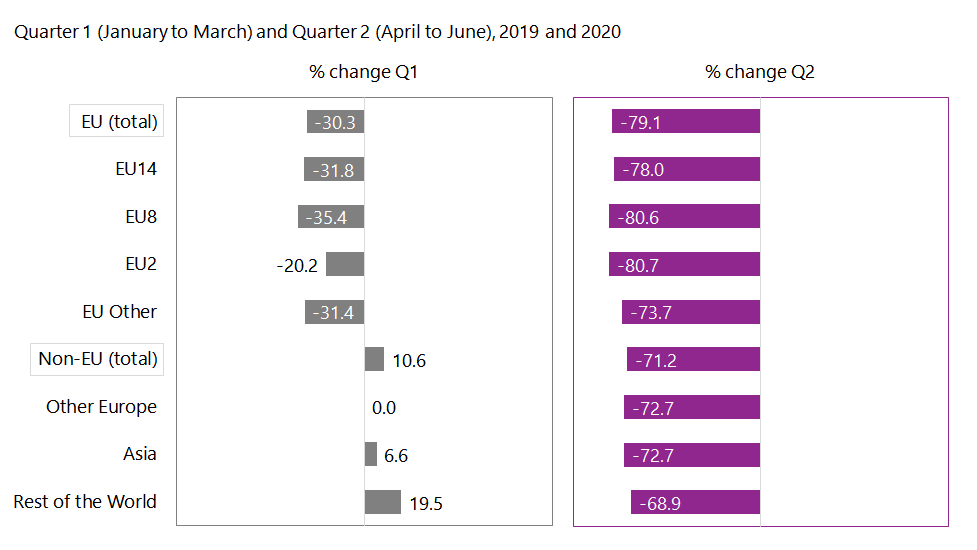
Source: National Insurance number allocations to adult overseas nationals entering the UK to June 2020, Department for Work and Pensions
While these are the largest decreases in quarterly allocations since the start of the time series in 2002, it is important to acknowledge that the NINo allocation process was severely disrupted as a result of the COVID-19 pandemic, with DWP staff being redeployed to other priority areas (e.g. to work on Universal Credit applications given the unprecedented demand for financial assistance). So these operational disruptions are also influencing the figures shown in Figure 6.6 as well as changes to demand for NINo services.
How have international travel patterns changed since the COVID-19 pandemic?
Statistics on passenger numbers generally show variability in trends due to seasonal effects or various social and economic factors, but can be used to provide early insight and context to the official migration statistics reported earlier in this chapter.
Figure 6.7: Annual percentage change in monthly air passenger movements between Scottish airports and EU and non-EU airports, January to June, 2019 and 2020
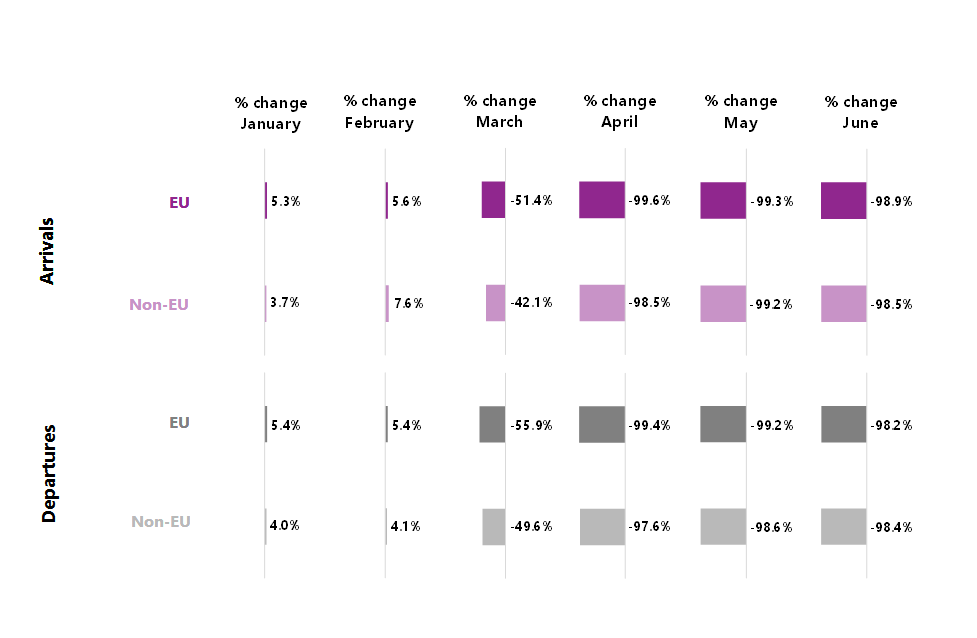
Source: Migration Statistics Quarterly Report, August 2020, ONS, Civil Aviation Authority data
Due to COVID-19, travel restrictions have been implemented in many parts of the world and this has had an impact on the volume of passengers flying between Scotland and other non-UK countries. As expected, total passenger numbers arriving to and departing from Scotland were significantly lower in March 2020 compared with March 2019 (Figure 6.7). Following this, in the months of April to June 2020, there were further reductions, with a decline of over 97% in both passenger arrivals and departures at Scottish airports from/to EU and non-EU countries compared with the same months in 2019.
Civil Aviation Authority statistics
The Civil Aviation Authority (CAA) collects statistics from over 60 UK airports. This includes total passenger numbers for international air travel between most UK and foreign airports (Table 12.1) as reported by airlines.
Importantly, they cover international air travel by all passengers, not just international migrants. They do not provide information about a passenger’s nationality or country of residence, and are not a direct measure of international migration.
Also, the figures may not reflect the complete air journey of a passenger: the point at which they disembark from one service may not represent their ultimate destination. Additionally, passengers might continue their travel by other means. For example, visitors might arrive at an English airport and continue their journey to Scotland by rail. Some airlines, aircrafts and passengers are also excluded from CAA data.
More information can be found on the CAA website.